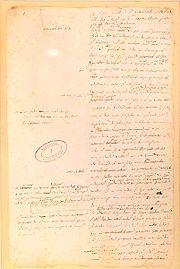Amsterdam-Spinozawalk ‘Evolution of mind’
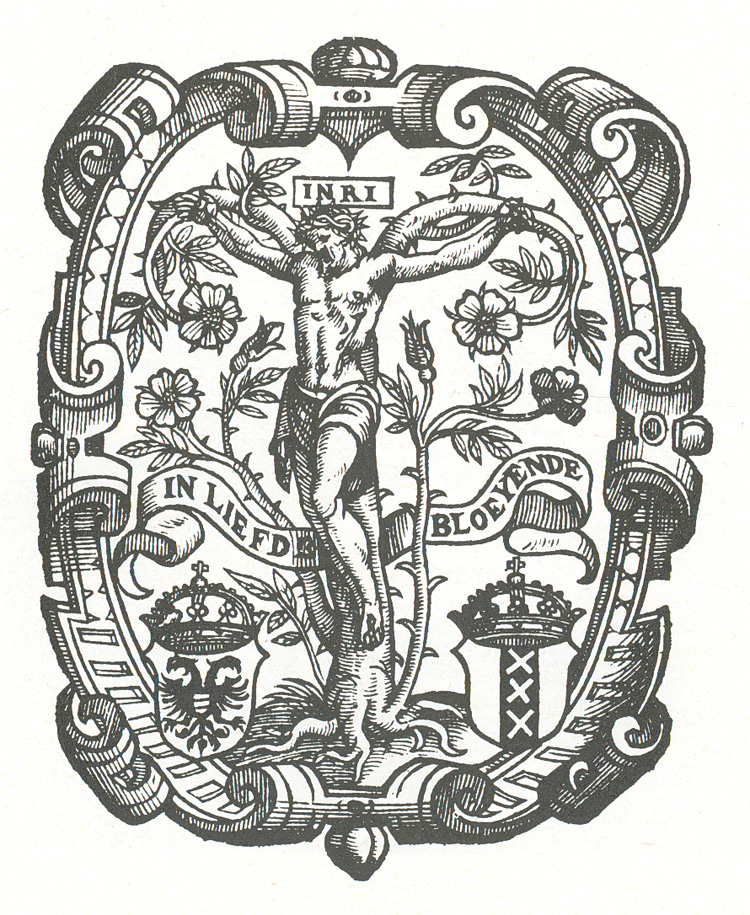
SYMBOL OF AMSTERDAM RHETORIC CHAMBER
d’EGELANTIER ‘IN LOVE WE FLOWER’
AMSTERDAM in the 16th and 17th century
SHORT SUMMARY 16th and 17th century developments in Amsterdam and the Republic
CHURCH AND STATE
In 1650 was Amsterdam on a peak. The revolt against the Spaniards was over. A large city House was built on the Dam and the enlargement of the city with the canals was in full swing. With the reformed States in Europe were coalitions formed and forged ties. France had with a visit of Maria de Medicis the Republic recognised. With the peace of Münster was the gradual reduction of 17 United provinces to seven of the Republic confirmed. The years between 1650 and 1672 knew (except diseases) new enemies: the English, who also won on New Amsterdam-country outside Europe and end 1960s fought the French under Louis XIV.
The city-holders Maurits, Frederick Hendrik, Willem II (died young in 1650) were succeeded by Johan de Witt in the stadtholderless period. In this period, Louis XIV makes preparations for war. It begins in late 1960s with territorial expansion, which leads to the intake of Utrecht in 1672. The 22-year-old William III is put in a form of city-holdership with close consultation with the States-General.
For the State law and the international contacts are important: Hugo de Groot; Furthermore, the diplomat Coenraat van Beuningen and 'Raadpensionaris' Constantijn Huygens.
In addition to religious freedom there is since 1579 a main church, the Calvinist, which is represented in the States and including care of Civil Affairs for non-secularism is. The officially recognized freedom of religion left space for non-Calvinists to the religion in house churches. This freedom brought with it an influx of people who were persecuted on religious grounds elsewhere, including many Flemings after the fall of Antwerp in 1585.
ECONOMY
The economy flourished. This was initially focused on the Baltic States: timber trade, grain trade, metal trade (including weapons). A certain degree of control was exercised so to monitor that the ' decent ' trade was. This contributed to many trade ran via Amsterdam. An important Amsterdams (trade) product was the book: in Amsterdam came many skills to create books together. In Flanders was the renaissance already further developed than in the more northern areas, mainly reflected in the painting and engraving art. This contributed to the thriving Amsterdam book printing company along with the rapidly evolving scientific knowledge in this period of ' scientific revolution '.
CULTURE AND RELIGION
In the Netherlands developed a Dutch renaissance (humans more than before) and classicism. The Italian trading cities and Flanders front herein were gone. Many Flemings brought this culture. The Italian cities were visited. Connected to the Florentine Court Ficino translated in 1471 the ' Corpus Hermeticum ', making knowledge of old pansofische and alchemical methods could be disseminated. Leonardo da Vinci gave attention to the harmonious, geometrical proportions of Vitruvius. The ' golden ratio ' was found. Culturally the rederijkerskamers played an important role. The most important was "In love bloeyende"-"of d'Egelantier. Started manifesting themselves on the streets, in the Nes, and later in the theater put it during more than a century, the show. There is a transition rather than thinking in specifically Christian imagination to a more universal natural philosophy. For some scientists is the traditional belief that contrary to perception, that for example the engineer Simon Stevin understandable believes that the religious content changes. But he (1590) sees a role for the faith and this would therefore in women and children should be encouraged. To a good education attaches much value.
Ecclesiastical leather pieces are increasingly outside the churches to freely discussed on collegiantenbijeenkomsten. In Amsterdam are Galenus Adr. de Haen and hebraicus Adam Boreel known collegiantenvoormannen. In rhetoricians and publishers circle consists interest Rozekruizersmanifesto's from 1614-1616. The travel and the development of microscope and telescope late new worlds. Constantijn Huygens (and many with him) comes to the conclusion that God is revealed not only in the Bíjbel but also by the "Book of nature". And later when with Descartes showed how an ingenious mechanics nature was, that there is a Divine architect. Cultural, religious and political area is the influence of Dirk Volkertsz Coornhert also after his death in 1590 large and identifiable.
During the 17th century discursive texts take an growing greater place in in relation to the visual and poetic (compact and with preservation of emotions): a shift from eye to ear. End 60-ties the culture one sees a new development; among other things, aimed at more standardisation in the language. In many areas, knowledge is systemized in encyclopedias. The old Theatre directors, including Vondel, must make way for the by Louis Meijer established NIL, what is strongly French oriented. The realistic paintings of Rembrandt will not fit in the high ideals of the painters of NIL.
SCIENCE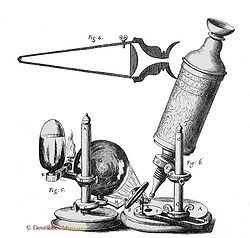
The development in the sciences and the possibilities of the applications had a broad interest. This went together with a desire to learn this in their own language, wide spread knowledge would then be possible. Amsterdam was, however, no University permitted and certainly no one in which the Dutch the official language was. Nevertheless could scholars who were persecuted elsewhere, here in compliance with certain caution, walk around freely. Even the controversial Descartes, who had influential protectors in Netherlands and the Dutch universities got here the first foothold with its mechanistic determinism. In combination with the publishing houses, this led to outside-academic exchange of science. There were contacts with English scientists who met outside the official University channels and an international exchange of knowledge stimulated by the effort of making and transleting bookf, who only much later found an official Royal recognition found in the establishment of the Royal Society.
STATE
Science at the courts come special scientists, artists and diplomats and meet each other, e.g. Descartes, Bacon, Cornelis Drebbel and Constantijn Huygens. In the 1950s and 1960s, the role and form of the State and of the head of State central to stand in politics: "opposite shock troops. Hobbes ' Leviathan appears also in the Dutch in 1667. There is even an eternal Edict promulgated: never a stadtholder! The invasion of the French and the subsequent war of 1672-1679, the stadtholder takes back back soon. Amsterdam is no longer a separate city, which with the water line can be sufficient for its defense. However, the power of the stadhouder strongly limited in comparison to that of other sovereigns: in close cooperation and under the supervision of the States of Holland. The Dutch glory time is then finally at an end, but will the ' Dutch model ', the values developed here both in own State legislation and abroad get a place. Stadtholder William III marries an English Duchess, a coalition with the English invigorating.
 VITRUVIAN MAN IN THE GOLDEN RATIO
VITRUVIAN MAN IN THE GOLDEN RATIO
WALK
In the construction art signs are the renaissance and classicism: the development of the perspective, the discovery of the golden section and the influence of Vitruvius (geometric proportions in nature). On the basis of the architecture and façade stones, the developments (in Spinoza's work come back) informative. Major architects and builders are: Hans Vredeman de Vries (perspective), Henrdrik de Keijzer (natural palette and performances), Jacob van Campen (more ' geometric '), Philip Vingboons (classicistic and nature). See for a ovesight of Classicist architecture: ' Samozzi in Amsterdam ' (VVV Amsterdam)
Interesting locations are: Dam, Nes, Schouwburg, House Churches (Singel at the height of the Spui), Keizersgracht 123.
| NUMMERS | LOCATIES AMSTERDAM | ONDERWERPEN |
| 1 | Nes 45, Brakke Grond | Introduction |
| 2 | Beurspoortje/Rokin | Fair, book shops |
| 3 *∆ |
Dam, Paleis op de Dam, Nieuwe Kerk |
Political theatre,, Nieuwe Kerk, * ∆ Stadhuis |
| 1 *g, 16 |
Nes 45/Brakke Grond, Gelderse kade 16 |
Rhetoric chambers/theatre on the street/Vondel |
| 1 *g | Oude Zijds Voorburgwal 282-296/Nes 45 |
Determinism/~ g Descartes |
| 9 *ÏÏ |
Oude Zijds Voorburgwal 231 | Need of science |
| 10 *g |
Oude Zijds Voorburgwal 300 | Facade bricks/(money)morals |
| 6 *∆TT |
Begijnhof | Position non-Calvinists: Catholiecs |
| 7 | Spui/Singel 452 (tLam) en Singel 118 (de Zon) | Positin non-Calvinists: Lutherans, mennonites, socinians |
| 11 | Waterlooplein | Position non-Calviniss: sefardic Jews |
| 5 | Kalverstraat (nabij Begijnhof), Westermarkt 6 | Hidden scientists |
1a. INTRODUCTION TO WALKS AMSTERDAM SPINOZA (Brakke Grond, Nes 45)
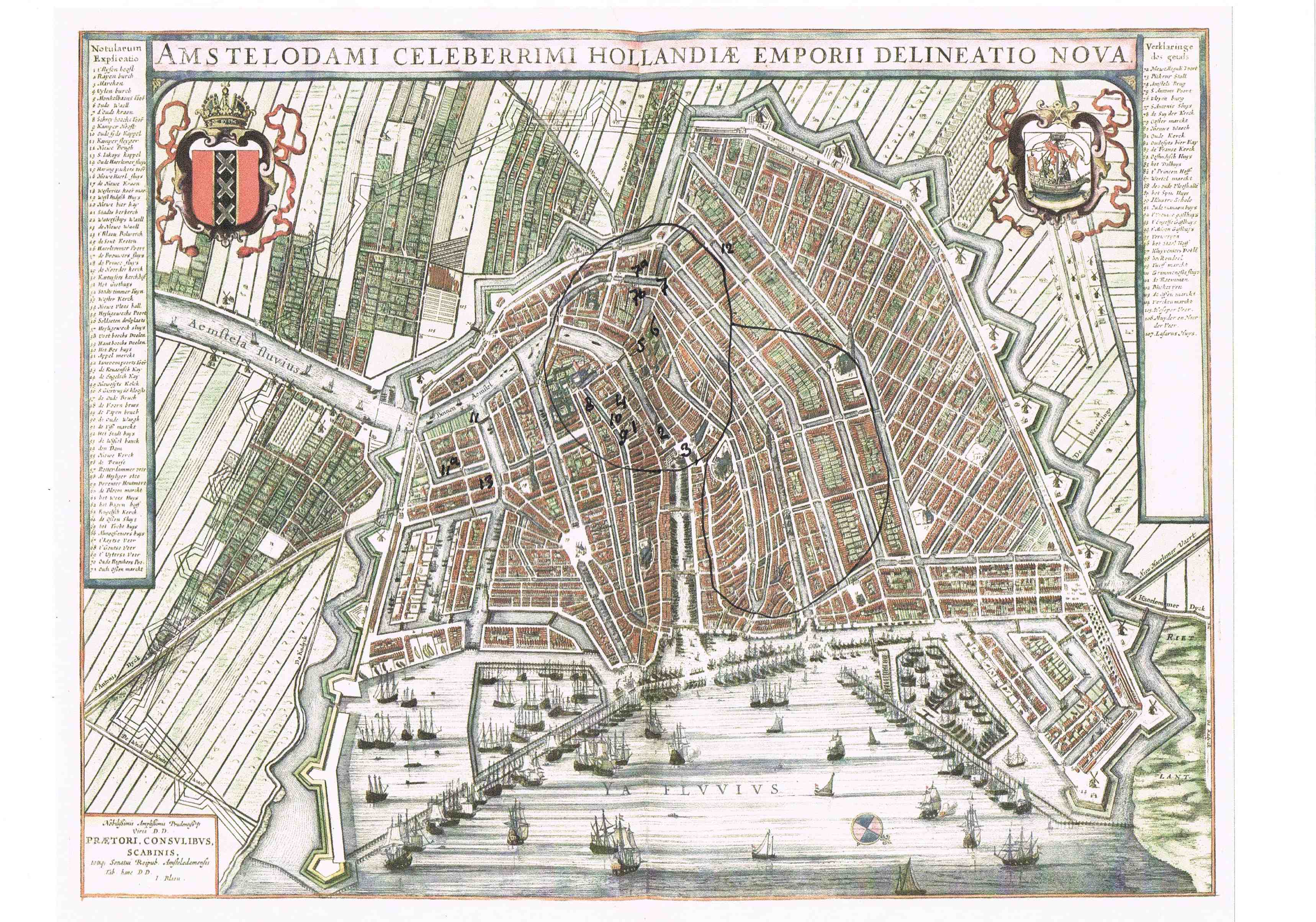
The walk ' Amsterdam Spinoza can start near the circled areas on the MAP FROM 1649 (left) South of the Dam along the spiritual ' beeldenstorm' (the non-violent 'storm' of changing ideas comparable to the, violent, storm that destroyed statues in catholic churches'), which took place in the 16th and 17th century in Amsterdam. Further along the Canal on the west side of Amsterdam. Old ideas were no longer obvious, such as about the existence of an afterlife in which one could be punished, or that man by the Fall would be bad of nature.
Spinoza (1632-1677) will between his 17th and 30th year, so roughly the period from 1649-1661, often will have been here in the Nes and its surroundings, first as a trader and later he must have lived somewhere here. Furthermore, he lived on the Singel and came in the Dirk van Hasselt steeg at his publisher Rieuwertsz. Influenced by what he saw and experienced in Amsterdam and from his conversations with friends and other contacts, whom he met here, he developed his theory.
On the walk is attention for the actualities of that period and the period before Spinoza and the ' visual representations ' in the art and architecture , the relative freedom in Amsterdam for people who were persecuted, the place of various churches elsewhere especially where it is relevant to understanding of Spinoza's work (see also the right-hand page; this provides connecting points on the route ' Singel 452 to the station ' to places to visitSpinoza or his friends, been where). Who were the "people of reason ', about who he writes in his Ethics ? Amsterdam in the period after the rise of the trade, the 'beeldenstorm', the 80-year-old war from 1650 until 1672 the change of flowering at the height to the invasion of the French in the Netherlands in the 'Disasteryear' 1672. A war that lasted until 1677 and after which the flowering period in the Netherlands was to an end.
Based on this web page different walks (also digitally) can be followed. In the page layout the initial location order at a first walk is released. At various points is a particular topic from his life or the Amsterdam background highlighted. The left of this web page outlines in particular the Amsterdam background; the right part put the spots on Spinoza, where he and his lots came and talked. And where they talked about. In the page layout does not follow the location order.
One can thus choose an own location order, depending on time and interest.On top stands (along with a drop on the right-hand page top) a walk that within the limits of 2 hours can be done, where his birth place and notes on his Jewish background is not included in the route.
The cultural development in the city can be read from the ornaments on homes and architecture. The following references are used:
* ÏÏ early Dutch Renaissance Hans Vredeman de Vries (1527-1606)
* g facade stone/image
* gb facade stonen/image (biblical)
* naturalistic ornament; Dutch renaissance; Hendrik de Keyzer (1565-1621)
* ∆ Dutch classicism; Jacob van Campen (1596-1657)
* ∆ TT Dutch classicism; Philip Vingboons (1607-1678)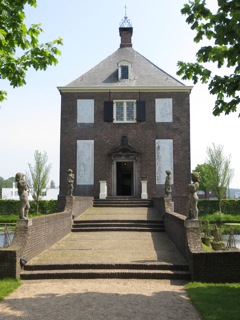 Out of the architectural designs speaks a strive for harmony. The in Italy discovered 'golden ratio' was recently applied. The discovery that mathematical ratios were often found throughout nature and are perceived by people as harmonious. Constantijn Huygens saw in that musical notes are formed by simple mathematical ratios. The Dutch classicism one can also to read good in ' Constantijn Huygens' 'HOFWIJCK ' (right), that Huygens designed together with Jacob van Campen influenced by Vitruvius.
Out of the architectural designs speaks a strive for harmony. The in Italy discovered 'golden ratio' was recently applied. The discovery that mathematical ratios were often found throughout nature and are perceived by people as harmonious. Constantijn Huygens saw in that musical notes are formed by simple mathematical ratios. The Dutch classicism one can also to read good in ' Constantijn Huygens' 'HOFWIJCK ' (right), that Huygens designed together with Jacob van Campen influenced by Vitruvius.  (see right Leonardo DA VINCI, 1452-1591, 'Vitruviusman' from 1590). The garden is an important part of the design. Also the current Bijbels Museum (Herengracht 364-370) from 1662 of Vingboons has a beautiful garden; inside is a odors Cabinet. The possibilities to discover Nature with microscope and telescope, lead Constantijn Huygens and many with him to the idea that God not only spoke to man through the Bible but also by the "Book of nature". Some other developments in thinking about God, nature and science at an international level expressed before 1648 in poems and engravings are here.
(see right Leonardo DA VINCI, 1452-1591, 'Vitruviusman' from 1590). The garden is an important part of the design. Also the current Bijbels Museum (Herengracht 364-370) from 1662 of Vingboons has a beautiful garden; inside is a odors Cabinet. The possibilities to discover Nature with microscope and telescope, lead Constantijn Huygens and many with him to the idea that God not only spoke to man through the Bible but also by the "Book of nature". Some other developments in thinking about God, nature and science at an international level expressed before 1648 in poems and engravings are here.
The title ' evolution of the mind ' refers to Jonathan Israel's book ' Revolution of mind; Radical enlightenment and the intellectual origins of modern democracy '. Unlike Israel, who focuses on the period during and long after Spinoza , this web page focuses on the evolution which had developed within the Netherlands (witin Amsterdam took a special stand) before and with Spinoza . The work of Spinoza is herin a scientific highlight. In Spinoza's own terms: the Amsterdam and the Republic after the Revolt (the Revolt from the Spanish, the 80-years War) were important work causes for Spinoza's work. Several scientists published pretty quickly after Spinoza's death work in his line, like the empiristic Enlightment philosopher John Locke, who also had lived in Amsterdam and was influenced by, inter alia, Hugo Grotius.
2. STOCK MARKET (Rokin/Beurspoortje near Dam)
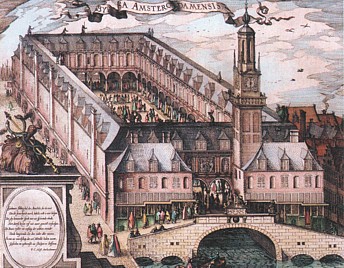 FAIR OF HENDRIK DE KEIJZER FROM 1611; SEEN FROM THE SOUTH; POSITIONED SOUTHSIDE OF THE DAM (ROKIN)
FAIR OF HENDRIK DE KEIJZER FROM 1611; SEEN FROM THE SOUTH; POSITIONED SOUTHSIDE OF THE DAM (ROKIN)
In the 16th century the Amsterdam trade had developed significantly . From 1611 stood on this spot already a big Fair, built by Hendrick de Keyser. The picture shows how lively it was around the fair. It is also shows that the Amstel flows here under the stock market.
The water, the trade, the stock market, are important links in the mental changes that took place. New ideas were also in other commercial cities with location on the water such as Antwerp, Bruges, Ghent, the Hanseatic cities, Venice.
The expansion of the overseas trade, the technique that was necessary, the opportunities to invest money and increase, all this brought immense changes, which went together with new ideas. For example, there came 'rules come about meetings at sea with ships of other countries.
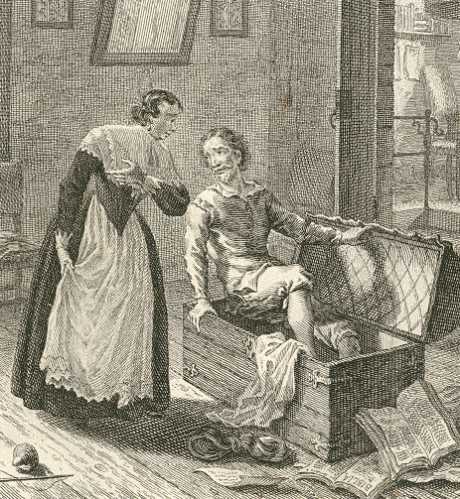
The jurist HUGO GROTIUS (1583-1645) (right, in books coffin) found that each ship should have right of passage, so that no trade was hindered. He develops a natural philosophy, which people and peoples of what religion or nationality for those reasons should make appointments about equal rights.
On the South side of the stock exchange are book shops. Books were a major commercial product for Amsterdam. Spinoza's publisher was Jan Rieuwertsz (1617-1687), who is also the publisher of the Dutch translation of Descartes. Click here for the exact locations of Stock market and Dam around 1630.
In Amsterdam is the most important part of the trade in the first half of the 17th century focused on the countries on the Baltic Sea, the Nordic trade. It has an important position in the trade because the traders have a name of reliability (information in the House of the grain inspectors in the N.Z. Kolk). The Witsenfamily (probably neighbours of Van den Enden), who later will deliver many mayors, were grain traders. Arms dealer Louis De Geer (1587-1652) is to a high degree involved in the struggle for the Reformed cause (with which Dutch Oranges had many bounds), among other things, in the 30-year-old war, has excellent contacts with Sweden and is strong internationally-oriented. In 1602 the Dutch East India Company is founded.
1b. RHETORIC CHAMBERS (Nes 45; Gelderse kade 16)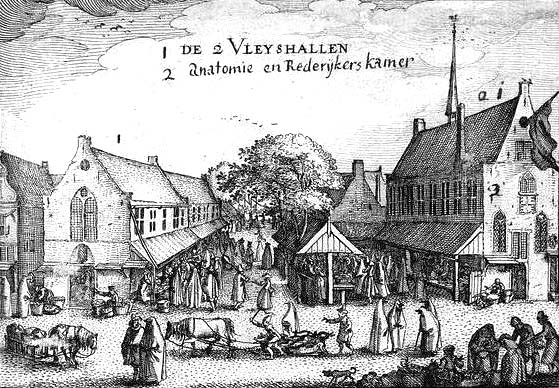
NES MEAT HALLS; ANATOMY;
RHETORIC CHAMBERS d'EGLANTIER ‘IN LIEFDE BLOEIENDE’AND 'WIT LAVENDEL'
In the Nes above the meat halls in the former Margaret monastery (right) came rhetoricians. The Eglantier existed from 1518. Rhetorics chambers were originally religious brotherhoods that enhanced ecclesiastical holidays with mystery-games, processions and tableau-vivants. 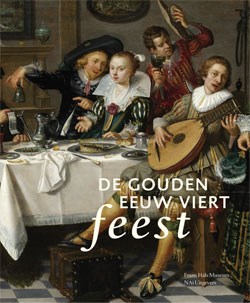
They have, inter alia, by their public street theatre a broad public. The rhetorics chambers in de Nederlanden did exchange mutual . It was often cheerful, as shown (right) on ornate paintings of FRANS HALS (1587-1666) from Haarlem, where the rhetrorics chamber "Trou must blyken ' was active. The Eglantier knew prominent members with poets as L.J. Spieghel (1549-1612), Roemer Visser (1547-1620), Bredero (1585-1618) and Hooft (1581-1647), who often also had political influence. In their poems and theatre pieces develops a new own ethics apart from a reference to a particular God. They often use
symbols from nature. They often come together in the house of Roemer Visscher (Gelderse kade 16) en lateron to Hooft op het Muiderslot.
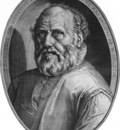
COORNHERT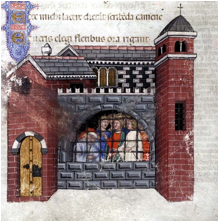 What around 1600 is conducted is often ' Ethics ' and is about the question ' How should I live in this changing time? '. Dirck Volkertsz Coornhert (1522-1590), member of "de Eglantier", wrote long before Spinoza in 1585 the first Dutch Ethica ' Zedekunst dat is wellevenskonste '. On the advice of his friend Spieghel he does not refer to God, although in Coornhert's own life the divine played an important role. Another important contribution of Dirck Volckertszoon Coornhert was the translation into Dutch of Latin works as of Seneca (-4-65) and Cicero (-106--43). In addition to this work on ethics from the Roman period he translated Boëthius ' Consolation of philosophy '. BOËTHIUS (480-525) wrote this book about the consolation of thinking from the prison (right). Dirck Volckertszoon Coornhert-himself calls the human thinking a ' vonxcen (spark) of the divine light '. Such well-chosen book translations contributed to the independent thinking in their own language , what could be spread among many provided by the not long ago developed techniques of bookprinting press. Dirck Volckertszoon Coornhert wrote in the form of conversations with friends such as Spiegel about ' the highest good ', about what is the most important thing in life.
What around 1600 is conducted is often ' Ethics ' and is about the question ' How should I live in this changing time? '. Dirck Volkertsz Coornhert (1522-1590), member of "de Eglantier", wrote long before Spinoza in 1585 the first Dutch Ethica ' Zedekunst dat is wellevenskonste '. On the advice of his friend Spieghel he does not refer to God, although in Coornhert's own life the divine played an important role. Another important contribution of Dirck Volckertszoon Coornhert was the translation into Dutch of Latin works as of Seneca (-4-65) and Cicero (-106--43). In addition to this work on ethics from the Roman period he translated Boëthius ' Consolation of philosophy '. BOËTHIUS (480-525) wrote this book about the consolation of thinking from the prison (right). Dirck Volckertszoon Coornhert-himself calls the human thinking a ' vonxcen (spark) of the divine light '. Such well-chosen book translations contributed to the independent thinking in their own language , what could be spread among many provided by the not long ago developed techniques of bookprinting press. Dirck Volckertszoon Coornhert wrote in the form of conversations with friends such as Spiegel about ' the highest good ', about what is the most important thing in life.
Within the theological controversies of his time, Dirck Volckertszoon Coornhert opposes Beza (1519-1605) and Calvin (1509-1564) on the predestination. This would mean that evil comes from God and would take away every motive to do well. This he argues in the line of Castellio (1515-1563), Franck (1499-1543) and Schwenkfeld (1489-1561). This way he advocates freedom of conscience, full freedom of religion and promotion of peace of religion.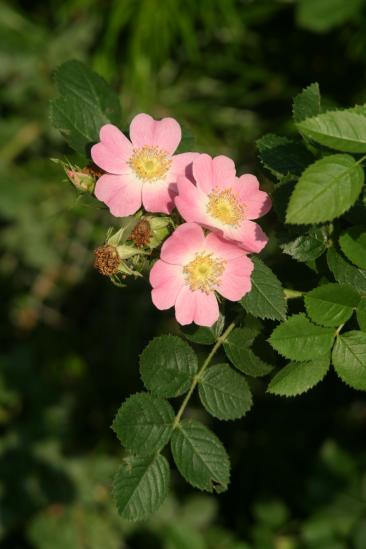
The blazon of the EGLANTIER (right), a rose, is by the graphic artist Dirck Volckertszoon Coornhert placed in its environment. The rose is visited by a bee, that the honey (love) spreads and is attacked by the parasitic Spider (danger!); the Rose has thorns developed. Spinoza's seal seems remarkably strong in the blazon of "de eglantier". Espinoza means ' thorn '. in his seal Spinoza used the same rose in conjunction with this ' defence-weapon ': a thorn and his device ' CAUTE ', ' BEWARE '. The appearance of the eglantine appears on the seal on the crucified on the blazon (see top). Next to each other the coat of arms and the seal form a (possibly accidental) illustration of the transition from religious thinking to natural philosophy and of Spinoza's equating God with nature. These two ways of thinking in the seventeenth century continued to coexist.
Natural ingeneer Simon Stevin(1548-1620) says in his book 'Het burgerlijck leven' (1590) that men of science may no longer believe in God, but they should behave and look if they do, while women and children should be encouraged in faith. In the beginning of the 17th century housed next to d'Egelantier the rhetoric chamber "Wit lavendel (White Lavender)" in the Nes/Brakke Grond (built in 1654). Of this chamner Vondel was a member. Bredero (member of "de Eglantier") is born on this spot (see wall-stone) and grew up here. Vondel grew up in the nearby Warmoesstraat . At a later age, he got a job at the Bank of Loann in the vicinity (Nes 57).
10. FACADE STONES/ (MONEY)MORALS (Oude Zijds Voorburgwal 300)
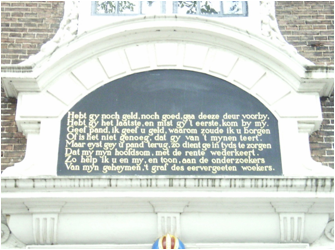
GABLE STONE ABOVE ENTRANCE CITY BANK OF LOAN: PRINCIPAL SUM Back with INTEREST
Suddenly people got financially successfull. How to deal with this new situation? New ideas were disseminated not only through the churches and theatre plays. At various places in the city witness the rhymes to the walls of a new morality. On the facade stone above the entrance of the Bank of LOAN is written that things of value can be loaned but must payed back with INTEREST (left).
The protestant ethics allowed profit making contraty to the catholic morals.
 GABLE STONE ABOVE SIDE ENTRANCE CITY BANK OF LOAN
GABLE STONE ABOVE SIDE ENTRANCE CITY BANK OF LOAN
There is still however a side entrance where the ' needy ' could pledge his stuff for a small amount .
Coornhert (see Schama) had put his ideas about wealth in the ' Comedy of the Rijckman '. The tenor in his financial ethics: wealth-itself is not wrong, only a wrong use of it. Coornhert's ethics is that of ' enough '. Towards the way of life of a character ' Need ' a lot ' he proposes ethics 'of enough '. This way of looking at money, is quite common in that time. What money is left after the ' enough ', goes to charities, for example to a court for the elderly '. Or it is spent on contracts to painters. It is known that De Geer as ' mercator sapiens ,( a merchant that money spents on sciences), became a patron of the Czech educator Comenius (1592-1670). This is also in line with Calvin.
Another well-known play (1617) with ' money'morals is ' Warenar ' of P.C. Hooft and S. Coster. Warenar is in fact not a Curmudgeon, but a tragicomic figure, whogets completely startled by an unexpected find , and gets totally mesmerized by this treasure. But at the end he is able to let go the treasure and give it away: so it was not avarice but obsession that kept him bound.
9. NEED FOR SCIENCE (Atheneum illustre; Oude Zijds Voorburgwal 231)
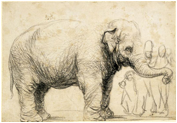
AN ELEPHANT ON THE DAM (REMBRANDT 1638)
In Amsterdam the sciences thrived as a result of the trade. There were created maps ; ship equipment was developed. People took a lot of things from distant regions. On Kloveniersburgwal 87-89 Blue-Jan shows his collection. Hansken is a born on Ceylon elephant which is brought to Amsterdam in 1633 with a ship of the United East India Company , and is shown on the Dam.
There arises a need for an Amsterdam University. By the existing universities is not, however, allowed a full University in Amsterdam. In 1632 is opened one on a limited scale, the Athenaeum Illustre University. A training for a study in Leiden. There were the exams were done. So the control on science maintains with Leiden professors as Gomarus (1563-1641). And Revius (1586–1658), one of the fiercest advocates of heretic persecution. He had a predecessor had in Lipsius (1547-1606): ' man must accept his destiny '. The killing of heretics in his eyes was inevitable. ' Burn evil to keep away the whole '. Gomarus was the opponent of Arminius (1560-1609).
Arminius was initially quite strict in the learnings. When he tried to refute the views of the liberal Dirck Volckertszoon Coornhert and deepened his ideas, he was grabbed by his tolerance-ideal. 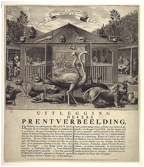
He became one of the most tolerant religious leaders of our country and had particularly among intellectuls many supporters. Although the population on the large was on the hand was of Gomarus, most intellectuals were Arminians.
Constantijn Huygens (1596-1687) had a high position at the Court of Frederick Hendrik. This way he could put a large weight on his art collection and he could also finance Vossius and Barlaeus. At the opening Barlaeus (1584-1648) talked (he talked about moderation of the desire for money), the arminian Vossius (1577-1649) (in his lecture that science gives the cause of everything) and Hugo de Groot (Grotius) were present. Also spoke Hortensius (1605-1639), which stood in contact with the Bredaase Beeckmans (1588-1637), the mathematician who influenced Descartes .
It was at least something, but people like Coster and Bredero, Hooft would have preferred to have had a University with Dutch as language.
(top right) Collection of BLUE-JAN (Kloveniersburgwal)
1. DETERMINISM/DESCARTES (Oude Zijds Voorburgwal 282-296/ Nes 45. Brakke Grond)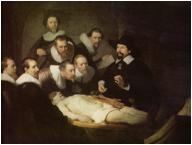
ANATOMIC LESSON OF NICOLAAS TULP (REMBRANDT, 1632)
At that time (Flemish) doctors operated there in the buildings to the Nes now and then . Rembrandt painted "the anatomy lesson of Nicolaas Tulp (1593-1674) '. It shows the at that time increased interest in the body.
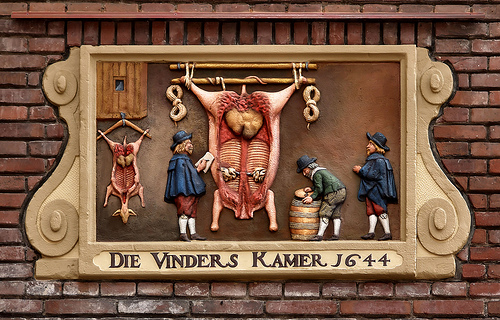
On the ground floor there were here meat halls. The presence of the Guild of meat inspectors (' The Finders room ', right) shows a façade stone on the Nespleintje. It is known that DESCARTES (1590-1650) likes to look around and study in meat shops. In doing so, he discovered that the heart is not a mystical body, but a kind of pump which works according to logical laws of cause and effect. The functioning of the heart is a well known example in the explanation of his scientific method (in ' Discours de la methode ' from 1637), which aims to expose the laws of cause and effect. His method laid the basis for the contemporary scientific activities. Descartes was initially very controversial at the universities. The Cartesian philosophy was the basis for ' mechanization ' of the world view and is based on the rationale that all human knowledge one systematic, organized hierarchically, construction work.
3. POLITICAL POWER IN AMSTERDAM (Dam) 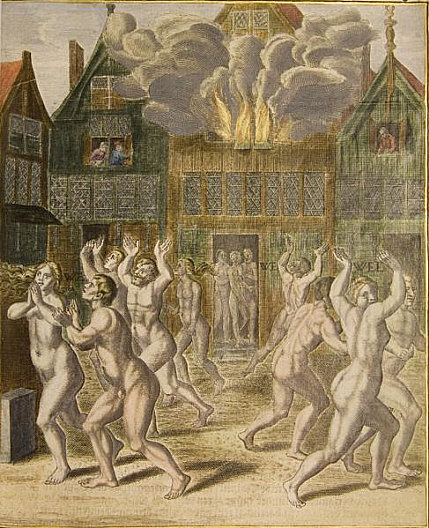
The Dam formed by the years an important stage for real political power and indicated.
ANABAPTISM UPRISING on the DAM 1535
Already in 1535 was the Dam been onstage for a revolt of the ' WEDERDOPERS ' (engraving by Claes Jansz fisherman, left). They held a demonstration by walking nudely . This way they expressed their ideal of equality of all people. This peaceful demonstration was harshly suppressed by the police. Executions followed.
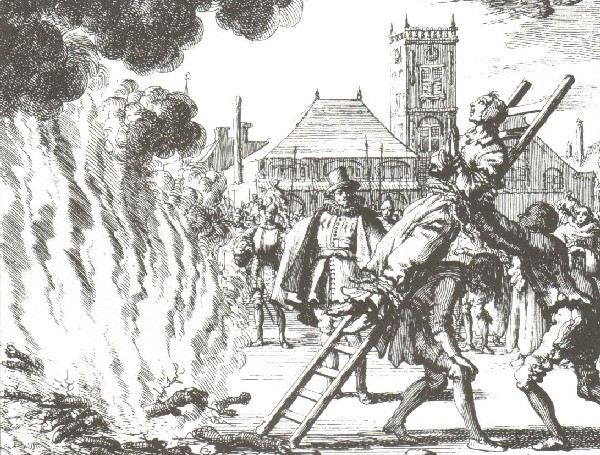
The Mennonite ANNEKEN HENDRIKS (right) in 1571 was executed on the Dam. She was thrown into the fire with gunpowder in the mouth. BY this way of penalties, the Authority wanted to make clear to the public what was not allowed and what could happen when forbidden were violated.
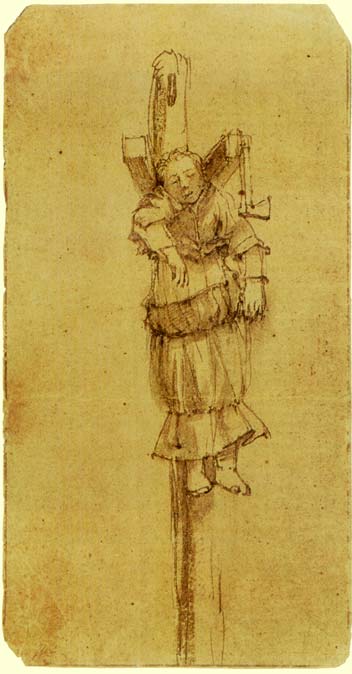
Dirck Volckertszoon Coornhert lived around the corner In 1535 in the Warmoesstraat 111. He then was 13 years old. Such scenes laid possibly a basis for his later fight against killing heretics. And for his ideas about reform of criminal law and criminal practice, also for other lawbreakers than conscientious objectors and political prisoners.
From the City Hall was spoken justice. To the public hanging on the Dam many people came to watchi. Rembrandt made in 1664 a drawing of Elsje Christiaans.
ELSJE CHRISTIAANS (left).
after the execution It was to see on the Galgenveld in North, along with the cause of her execution: the axe with which she had killed someone.
ALTERATION
Although there existed freedom of religion in the Republic, the reformed Calvinist Church was since the ALTERATION (under) in 1578 the official Church in Amsterdam. The official Church had, inter alia, the task of care of services for everyone, like a marriage and funerals. In Amsterdam a rebellion on the Dam had preceded the alteration. Since then were here on the Dam in the from origin Catholic Church ('Nieuwe Kerk') reformed services were held. The merits of the Calvinists in the rebellion and war against the Spaniards had made them claim that special position.In fact, Amsterdam, where lived a lot of Catholics, had not wanted this, just as William the Silent and D.V. Coornhert. Fanatic, sometimes cruel, calvinist 'geuzen'-troops under Lumey had spilt more blood than only of Spanish troops and sometimes more than was necessary for a victory.
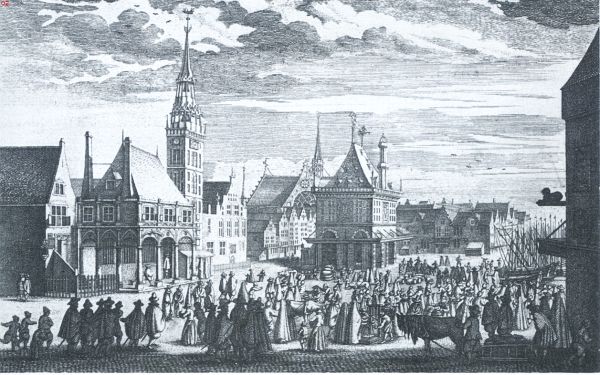
ICONOCLASTM
After the iconoclasm of 1566 are the Church Interiors gradually sobered up.
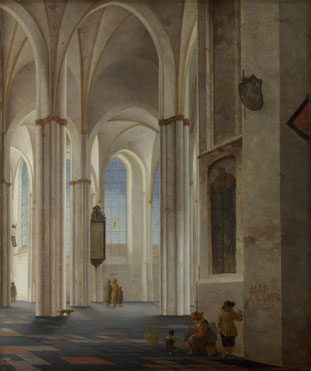
Pieter SAENREDAM'S (right) 'Buurkerk' church shows a high area of light, as it were, a celestial Dome, in which man scratches his experiences on the wall. Services are held in the Dutch. The Bible is read in Dutch. And to the own time interpreted.
Also the synagogue of the Portuguese Jews, which is built in 1667, is made in this style. The Interior of the synagogue resembles the austere Protestant churches with a starring role for the light.
Outside the church the Calvinists could spread moral ideas hrough gable stones. An example is the stone with a ' vermaan' rhyme on the changing fate.
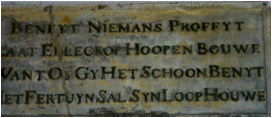 'VERMAAN' (ADMONISH) RHYME ABOUT THE CHANGING FATE (Pentagon)
'VERMAAN' (ADMONISH) RHYME ABOUT THE CHANGING FATE (Pentagon)
BENYT NIEMANS PROFFYT
LÁÁT ELLECK OP HOOPEN BOUWE
WANT OF GY HET SCHOON BENYT
HET FERTUYN SAL SYN LOOP HOUWE
6. POSITION OF NON-CALVINISTS: CATHOLICS (Begijnhof; R.K. Chapel, ∆TT)
For non-reformed believers was needed to adapt to the rule: ' there is freedom of religion, but you should not do services openly '. E.g., no chimes. Only Calvinist clock pealing was allowed. At the Begijnhof one can see that houses from outside look like homes, but inside are furnished as church. The Catholic Philip Vingboons designed the Catholic home chapel in 1671

(left) OUTSIDE R.K. CHAPEL BEGIJNHOF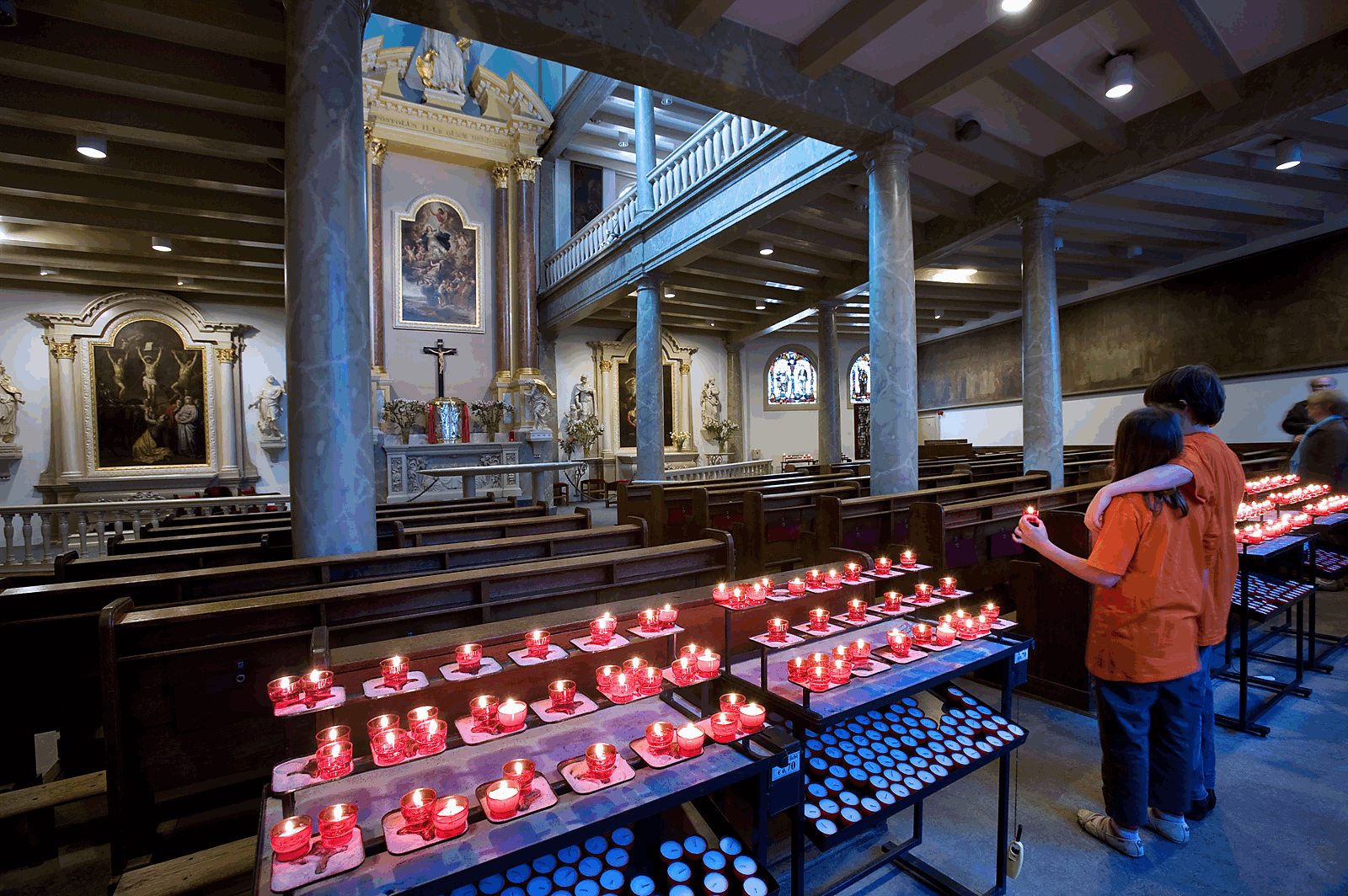
INTERIOR (right)
In 1579 is much Catholic possession passed to the Calvinists. The transfered churches were gradually ceded to different religious groups, who stayed in Amsterdam. The former Catholic Church, opposite the hiding Catholic Chapel, became an English Church in 1607 . There came the Pilgrim Fathers among others. A painful situation for the Catholic believers.
On the spot of the current Moses and Aäronkerk (Waterlooplein 207/Jodenbreestraat) stood from 1640 a Franciscan House Church.
7. POSITION OF NON-CALVINISTS: MENNONITES; LUTHERANS (Spui/Singel)
The Church played an important role at this time. For various reasons in Europe were new denominations, which no longer felt at home in the Catholic Church. Luther had opposed the trade in indulgences of the Roman Catholic Church. Furthermore, there had been a process of gradually loosing dogmatic ideas. This led to a series of new denominations such as Mennonites, Lutheranians, Remonstrants.
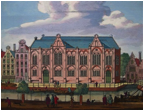
7b. SIDE OF LUTHERANIAN CHURCH/ SPUI
At Singel 411 stands a Lutheran Church from 1633. The Spui-side still shows that the services before 1633 in took place 7 contracted homes. The timber trade with the northern countries in this period was still very important. Intervention of the for Hanseatic trade important Danish King, has achieved that the Lutheran Church got this the more official status in Amsterdam.
7c.MENNONITITE COMMUNITY (Singel )
SINGEL 452 FRONT (left) 
Moments later one sees on the other side the Flemish-Mennonite Church 'Near the Lamb' (on Singel 460). The front looks like an ordinary House. On the facade a ' normal ' reference of a lamb refering to the adjacent former brewery and pub 't Lam '. To the rear (right) is the nicer, actual entrance of the Mennonite Church. Within a sober Interior without images.
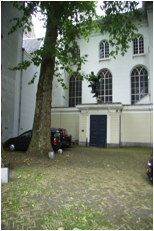 Mennonite churches were sometimes not churches but shelters ' 'Vermaninghe'/Admonitions '. Within the Mennonites plenty of currents are to distinguish. Much information stands on www.gameo.org/encyclopedia. Further north on the Singel sat ' Waterlanders ' and ' the Sun ' . In general, they were of an Apostolic Christianity: Christ as an example and inspiration for a 'virtuous' life. From its members was asked an active choice for the faith by baptizing on an adult age .
Mennonite churches were sometimes not churches but shelters ' 'Vermaninghe'/Admonitions '. Within the Mennonites plenty of currents are to distinguish. Much information stands on www.gameo.org/encyclopedia. Further north on the Singel sat ' Waterlanders ' and ' the Sun ' . In general, they were of an Apostolic Christianity: Christ as an example and inspiration for a 'virtuous' life. From its members was asked an active choice for the faith by baptizing on an adult age .
Mutual there was pretty much squabbling between these three currents. As regards in dealings with the world around them the Waterlanders were the most mondane and outside-directed and had of the three Mennonite currents most wellknown members. They mainly based on their own interpretation of the New Testament and did not ban members soon (also the Mennonites as the Sefardics banned sometimes members).
The well-known poet Vondel, a Mennonite from home and deacon at the 'Waterlanders' (1616-1620), which was then located in the Oude Nieuwstraat, came into conflict with them. He wanted to remain faithful to the Bible, not so much to the inner conviction. When he got enough of the differences he joined the Roman Catholic Church The Krijtberg (Singel 448).
The Waterlanders and the Sun were to the North: the Waterlanders/ ' In den Toren ", i.e. at the bridge made by Leeghwater (also a Mennonite) Singel 159. The entrance to the Sun is seen at Herengracht 109-111 (above the gate is a small relief of a Sun). What Mennonites had in common was that they are preferably settled in ' right'side of the city (seen from the North): the Western ' Nieuwe Zijds '. This initially had a religious basis; moreover, was the former property of the Catholics in the form of monasteries, mostly located on the East side of Amsterdam.
7d. SOCIANISM
In principle there was freedom of religion, although not all religions could be professed publicly. Also the many immigrants could profess their religion. On order of the Church Council in 1648 and later by the States the socianism was forbidden. Socinus (1535-1604) taught that only the New Testament had to be recognised as a source of intellectually explainable revelation; that there was one God, not three; that there existed no original sin and no predestination. Christ was not Savior by the cross death but by his moral example. Later, these were called unitarians, who included for a long time a considerable group of faithful Christians (Jon Israel, 2010, ho V).
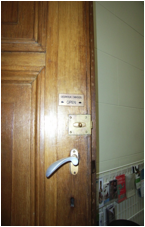
In the Mennonite Church 'Near the Lamb' socinian church services were held, witness the awkward door button (you had to go up instead of down), which is made at the entrance to the Church room to incident police men to slow down, so that in timeto a Lutheran service could be switched.
AKWARD DOOR BUTTON
A pastor with socinian ideas was Galenus Abrahamsz de Haan (1622-1706). Hej also spoke in public on the Rokin like other collegiants-leader Adam Boreel. In J. Lindeboom 'Stiefkinderen van het Christendom' are many currents and their connections to several persons mentioned on this website with explanation.
A related movement with the socinianism was that of the sacrementarians, who rejected the real presence of Christ in the sacrament of the supper. David Joris (1501-1556) had previously sympathised with this flow. Later within the Liberal Church history of the 19th and 20th centuries this sacrementarians are seen as exponents of the reasonable, elastic Protestant folk tradition that supposedly reflected the Dutch nature .
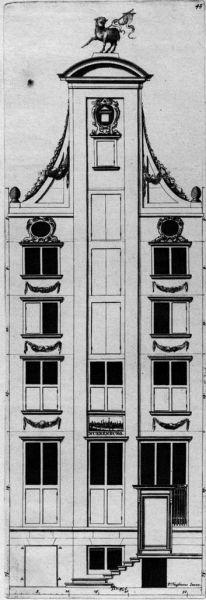 7e. the LAMB, SYMBOL OF THE BOHEMIAN BROTHERHOOD (Singel 460)
7e. the LAMB, SYMBOL OF THE BOHEMIAN BROTHERHOOD (Singel 460)
The lamb on the Mennonite home church 'Near the Lamb', Singel 452, refered to the initially adjacent café 't Lam (location the current Odeon). On top stood for a long time (at least until 1817; from at least 1648) a sheep with the FLAG, symbol of the Bohemian brotherhood, and later that of the Moravian School of the Moravian community. Already before the current building built in 1663 by Vingboons for Gillis Marcellis was built, stood this symbol on the Cafe/brewery, as can be seen on Van der Helst ' Shooters meal ' from 1648 on the occasion of the peace of Münster. Comenius was connected with the Bohemian brotherhood, where he has been a priest for some time.
In Amsterdam there is interest in the work of the ancient Egyptian way Hermes Trismegistus, a related current. Ficino and Paracelsus are in the late Middle Ages, important in the further development and dissemination of these ideas. In 1614-1616 appears three Rosicrucian manifests. Herefore is In the first half of the 17th century in Amsterdam in various circles interest, including in Rhetoric circle (Roemer Visscher). Lateron Comenius ' ideas go more and more in the direction of eocumenism. The owner of brewery 't Lam was also owner of the adjacent buildings in which the Flemish-Mennonite House Church 't Lam and the Catholic House Church de Krijtberg were housed : in total an real oecomenic angle.
7f. SYNAGOGUE and school of TALMUD TORA ( Waterlooplein 133/156, 'De Herschepping' and next to Mozes en Aäronkerk, 205)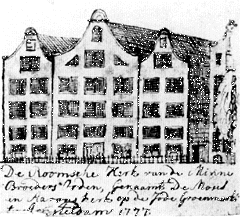
 The sefardic Jews had until 1639 HOUSE-SYNAGOGUES (links). These unite in one synagogue location Waterlooplein 205.
The sefardic Jews had until 1639 HOUSE-SYNAGOGUES (links). These unite in one synagogue location Waterlooplein 205.
In one of the adjoining houses would Spinoza are born (also called as place of birth is Zwanenburgwal 15).
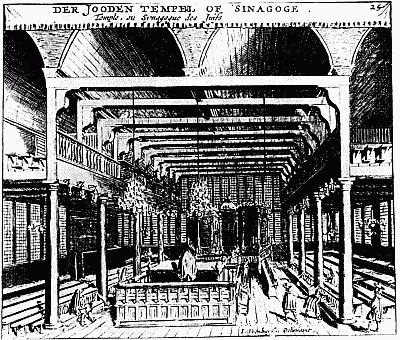
In 1639 on the Houtgracht (now Waterlooplein 133/156) the synagogue built in Classicist style of the society the TALMUD TORA (right) is opened. See also the Interior (right). On the Houtgracht stands next to the synagogue the school where Spinoza got lessons and which he visited untill his 15th year .
7g. WALLOON CHURCH (30. Walenpleintje 159; naast Oude Zijds Achterburgwal 155)
In 1578 came here a Walloon Church for Huguenots, French followers of Calvin. After been at first chased in France, they were lateron protected by the Edict of Nantes. Louis XIV raised this Edict in 1685. This led to a large influx of Huguenots in the Netherlands including Amsterdam. There are several other Walloon churches built in Amsterdam. Orange was often strongly linked with the Walloon Church. Stadtholder William III was baptized in a Walloon Church .
7h. The REMONSTRANT HOMECHURCH 'RED HEAD'
In the thirties the remonstrants got a home church on Keizersgracht 108 (with a façade stone ' RED HAT ')
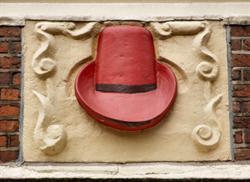 The remonstrants, successors of Arminianism, had a lot of support in this part of Amsterdam. Put Their opponents putted except Arminius and Wttenbogaert, also the Anabaptist David Joris and Dirck Volckertszoon Coornhert on the ' Arminaense Dreckwagen '. And Johan van Oldenbarneveldt assigns them the way. The remonstrant Pastor Johannes Wttenbogaert (1557-1644) is the successor of Arminius. Wttenbogaert was supported by the family Reaal. Laurens Reaal (1583-1637) had exceptional ideas, even exceptonal in the remonstrant circle: he stands for letting the natives benefit of the exceptional revenues of VOC and WIC-Trade Commission .
The remonstrants, successors of Arminianism, had a lot of support in this part of Amsterdam. Put Their opponents putted except Arminius and Wttenbogaert, also the Anabaptist David Joris and Dirck Volckertszoon Coornhert on the ' Arminaense Dreckwagen '. And Johan van Oldenbarneveldt assigns them the way. The remonstrant Pastor Johannes Wttenbogaert (1557-1644) is the successor of Arminius. Wttenbogaert was supported by the family Reaal. Laurens Reaal (1583-1637) had exceptional ideas, even exceptonal in the remonstrant circle: he stands for letting the natives benefit of the exceptional revenues of VOC and WIC-Trade Commission .
1.c. POLITICS AND RHETORICS (Dam/ Brakke Grond, Nes 45; geometry school of S.H. Cardinael in Nieuwe Nieuwstraat 20)
Gradually the rhetoricians-pieces get a more mundane form and poetry and rhetoric -in classical rhetoric way- was practiced. Pieces of religious or moralistic content are now interspersed with mythological and heroic stories. This general trend is also been seen at the 'Egelantier' and 'White Lavender'. Lyricist and mayors sonP. C. Hooft had a great influence on the new development in the theatrical art, in which the classical drama got a large role. For example a piece of Terentius (-195 to-159) was transformed by Bredero (1585-1618) to his ' Moortje ' (1614). In this Renaissance comedy Bredero followed the classical piece, adapting it to the circumstances that he knew. Some, such as Joost van den Vondel (1587-1679), wanted to overtake the classic tragedy and surpass the writers. For Vondel this meant to transform Biblical substance in the form of a classical tragedy.
There was sufficient material for drama and tragedy to find in their own country.
Many struggles, war and iconoclastic had happened in the preceding centuries. Many were executed or exiled with dissent. Many famous scholars, writers and statesmen are jailed or killed. Or should have been absconding, or were ,reviled like on the cartoon 'd'Arminiaanse Dreckwagen' 'Arminian Shitwagon'.
For example, Prince William of Orange (1533-1584), who in 1582 was declared outlaw after the Dutch 'ACTE VAN VERLATINGHE', the Declaration of independence (right) on 26-06-1581 and was assassinated in 1584 after an amount of money which was put on his head. Also Dirck Volckertszoon Coornhert (1522-1580) was in prison and had to submerge at collegiants. Many, who are killed or imprisoned because of their opinions, are anonymous. As the "Rebaptizers" sfter their rebellion in 1535 in Amsterdam. The ' Revolt ' against the Spaniards took many lives.
The statesman Van Oldenbarnevelt (1547-1614) was in 1618 at the Binnenhof was beheaded because he wanted to protect the freedom of expression of Arminianism. His Secretary Hugo Grotius was jailed in castle Loevestijn. This played a role that some wanted to continue war (Maurits), like Van Oldenbarneveldt, were in favour of peace. This last had resulted in the 12-year-old ceas-fire (1609-1621).
In the controversy between Gomarists (' camp Calvinists ') and Arminianists (' camp Anabaptists of the Dreckwagen ') played the issue of free will. Maurits wanted to preserve the unity of religion before everything, although Arminius had been his own Pastor.
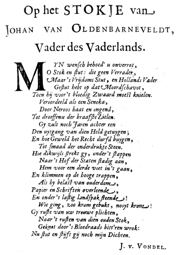 VONDEL ABOUT VAN OLDENBARNEVELDT
VONDEL ABOUT VAN OLDENBARNEVELDT
he rhetoricians dealt with these political experiences in their work. Through art criticism could be expressed. Vondel wrote (long time forbidden) poems and plays about this. Known is his ' Stick of Oldenbarneveldt '. He chooses party for those who defended freedom of expression. Although the allusions of Oldebarneveldt were discovered, it was covered and had the States wanted to condemn Vondel. Amsterdam foreclosed this however.
In other poems let him see the sadness that war entails. The poems are about the mothers, that mourning for their sons and husbands.
In 1617 by Samuel Coster de Nederduytsche academie was founded as a Chamber of rhetoric, escutcheon with a bee hive under an Eglantine, and the motto ' Zeal '. This dedicated itself mainly to the provision of higher education in the vernacular. Pitch was the later Theatre on the Keizersgracht. The Calvinist consistory did not like the creation. They urged the Amsterdam City Government, the 'Vroedschap', to make it close. There was objection to the two Mennonite professors, including the mathematician Sybrandt Hansz. Cardinael. This had a school from 1605 in the new Nieuwstraat 20. Also the contents of the theatre pieces they did not like. The educational institution was in 1618 closed and the performance of pieces ceased in 1622. Vondel's ' Vraghe of d'Amsterdamsche Academi to all poets and poets ' (1631) lead to vehement responses of the Calvinists. However in 1632 ' the ' Athenaeum Illustre could be opened.
2b THEATRE PLAYS ON THE STREET (Rokin/Beurspoortje)
TABLEAU VIVANT AT THE VISIT OF MARIA DE MEDICIS (1638)
Scenes at markets and squares dit the rhetoric chambers traditionally. Was the work of Dirck Volckertszoon Coornhert especially focused on finding the highest happiness in themselves and on the passing of experience to a next generation, on mild legislation and manners, based on knowledge ('know or rest '), on criminal justice innovation and against the killing of people with differing opinions as hereticsin the 17th century, gradually increased the number of pieces , which had a political information function for the people. Also the range of the performances became wider.
MARIA DE MEDICIS 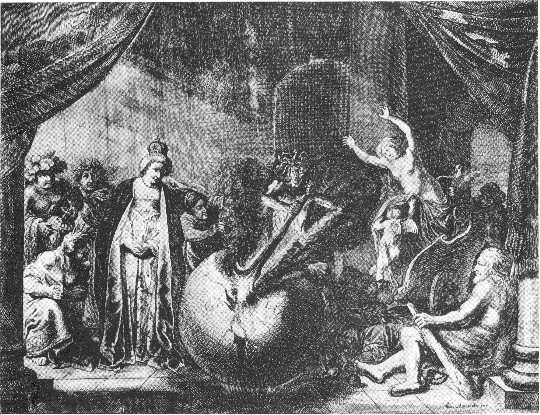 IN A SCENE
IN A SCENE
In command of the Government 'd'Egllantier ' played during the 12-year ceasefire with Spain from 1609-1621 applicable stories from Roman history. In the tyranny of the last Roman King Tarquinius, the attainder of LUCRETIA (in right column, painted by Rembrandt) and the foiled conspiracy of Brutus could the audience recognize allusions to the own history of the eighty years war. This kind of festivities were usually in a furious pace-about ten days-to be prepared by the Director of the whole Samuel Coster.
Absolute highlight of such theatre festivals was the visit of France's Queen Mother Marie de Medici in 1638 to the Republic. It was seenas an informal French recognition of the Dutch Republic. The reception was generous . MARIA DE MEDICIS (top right), the other guests, the mayors of the city, they drove all in their barques on the water of the Rokin, where Neptune bobbed to meet Maria and the cities virgin ('stedenmaagd ') and the god of trade Mercury greeted her . This kind of theatre is to see until the end of the 1950s. This is then in other form continued in theater pieces that were performed in the theatre on the Keizersgracht.
On Keizersgracht 384, where first the ' First Nederduytsche Academy was housed in 1637, a new ' Schouwburg of van Campen was built. In 1665, the Baroque theatre was replaced by a new one, which made more theatrical stunts possible. Directors as Vondel are pushed aside.
In 1669 a new Board was installed under the leadership of the company NIL.  This has a more general new orientation of the Baroque theatre to performances in: on ' rational-classical ' bedrock Theatre according to the NIL VOLENTIBUS ARDUUM ideas of NIL = " nothing IS DIFFICULT for THOSE WHO WANT to ' (right; ' climbing to the laurel branch ").
This has a more general new orientation of the Baroque theatre to performances in: on ' rational-classical ' bedrock Theatre according to the NIL VOLENTIBUS ARDUUM ideas of NIL = " nothing IS DIFFICULT for THOSE WHO WANT to ' (right; ' climbing to the laurel branch ").
Lodewijk Meyer (1629-1681) who was from 1665-1669 Director of the theatre-old style, but gets disagreement with the leadership about the ' occasional Spanish repertoire ', is the founder of NIL in 1669.
NIL orientats on the rationalist and purist developments of the Academy Francaise, especially Corneille. Corneille's wrote Le Cid In 1637. In this piece he shows the difficult choice between love and honor, the choice falls on the 'honor'. A classical tragedy in which he kept as far as possible to the rules that were set by the Classicist aesthetics. In 1647 Corneille became member of the Académie française, which was founded in 1635 by Richelieu.
What implied the changes? In the theatre often classical pieces were played. This could be in the form of 1. replay of a piece written oin a Greek or Roman environment. 2. a second form was that the classic characters were placed in a Dutch environment. Vondel wrote Palamedes so that was to recognize that it was aboout Van Oldenbarnevelt. 3. a third form was that a classic piece underwent an improvement, which led to exaltation of the audience. Vondel placed than a classic piece in a biblical environment. An example is ' Jephtha'.
NIL also wanted to ' improve ' from a classical context, but in a totally different way, which was more based on ' rationality '. The Académie Française in Paris took the role of art judge and legislator. The members of NIL wanted to present the public who examples with a high degree of perfection. So the painters (including Gérard de Lairesse, 1640-1711) of NIL took an example in Zeuxis, who for a painting of the most beautiful woman takes a number of beautiful women as models and of all women the most beautiful appearances to combine this in one painting. Vondel is pushed aside and Rembrandt criticized: intolerable ugly. Just as Meijer publishes a handbook for the theatre, de Lairesse publishes a handbook for the (wallpaper) painting.
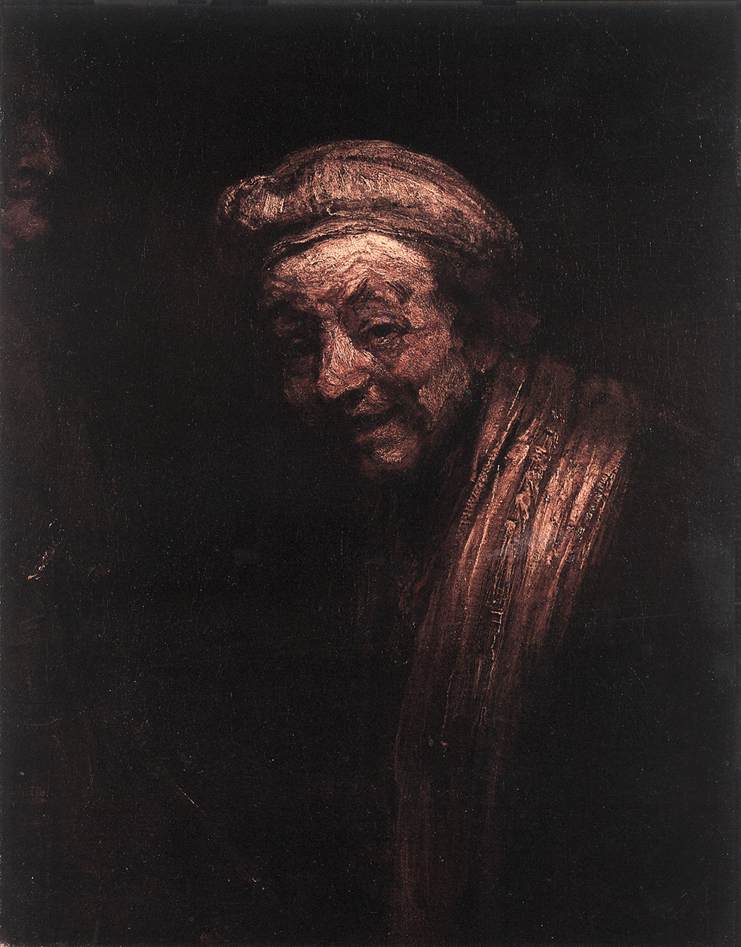
This his raises resistors and the laughter lust of Rembrandt, who provides comment on the ' self-portrait as ZEUXIS ' (left). He paints an ugly, smiling old man: himself. In a corner of the painting is still an old woman painted, but hardly visible. Rembrandt himself must be considered as the main topic. Zeuxis is a figure from antiquity, which laughed himself to death when he an painted in his old age an old woman: such an ugly old woman!!!
REMBRANDT is realistic enough to portray himself as old and is artist enough to that anyway in a nice way (and without laughing to death). He turns himself against currents in the art that wants only to show beautiful things by way of ' elevation ' of the people. He is a representant of the realistic DUTCH painting tradition. After Saskia's death, he develops the realistic style even further, often in religious paintings.
NIL seems strongly oriented on the (language) innovative currents in France, the Encyclopedists. The theatre work is more cheerful, more comedy, spectacle and technique. Between 1672 and 1677 is the Theatre closed due to the war with the French. Probably the Calvinist city fathers this a good thing. They are already annoyed at the pieces.
5. IN AMSTERDAM HIDDEN SCIENTISTS (Descartes: Kalverstraat, met opschrift: Westermarkt 6; Locke, Damstraat/Oude Hooghstraat, Westermarkt)
As was the case for the non-reformed believers to adapt to the line: ' there is freedom of religion, but you should not show with it ', so was also the rule for scholars with progressive ideas, which had too farfetched implications. A wide circle of people offered in general protection against actual persecution. In addition, Amsterdam did benefit from such free thinkers. If you're a bit calm, it was possible to find protection in Amsterdam.
Say where exactly in the Kalverstraat he lived, is unknown, probably in an old monastery, but (left), RENÉ DESCARTES (1596-1650) has lived here at least for a while. Later he lived some years on the Westermarkt 6. His ideas were very controversial. He had to be worn unobtrusively, but said: ' Hollanders are so busy with money, they don't take notice of me'. Descartes just as later Spinoza, from prudence, published a part of his work only until after his death. His publisher was Elsevier; translations into Dutch were issued by Jan Riewertsz, also the publisher of Spinoza.
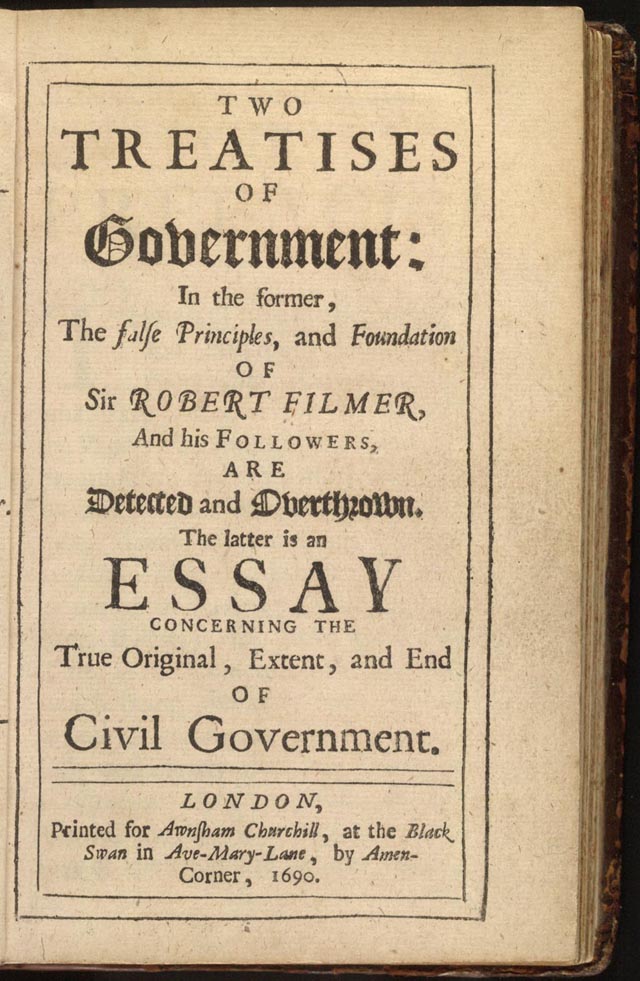 Other scholars have lived for a time in Amsterdam, among others (right) JOHN LOCKE (1632-1704) of 1683-1689 in the Damstraat. He writes than to two treatises on the State (right). Because he had to watch out for persecutors from England he took a pseudonym from caution: ' Doctor van der Linde '. It seems like a tribute to Hugo Grotius (1583-1645), who might have used the same pseudonym. Hugo Grotius-themselves was in 1618 as it simultaneously with of Oldenbarneveldt condemned but not like him beheaded, and walked after his well-known escape from the books kist openly around in Amsterdam . For example, he was present at the opening of the Athenaeum Illustre in 1632. Yet later, Hugo Grotius went to live in France.
Other scholars have lived for a time in Amsterdam, among others (right) JOHN LOCKE (1632-1704) of 1683-1689 in the Damstraat. He writes than to two treatises on the State (right). Because he had to watch out for persecutors from England he took a pseudonym from caution: ' Doctor van der Linde '. It seems like a tribute to Hugo Grotius (1583-1645), who might have used the same pseudonym. Hugo Grotius-themselves was in 1618 as it simultaneously with of Oldenbarneveldt condemned but not like him beheaded, and walked after his well-known escape from the books kist openly around in Amsterdam . For example, he was present at the opening of the Athenaeum Illustre in 1632. Yet later, Hugo Grotius went to live in France.
he freedom was not limited only by the Calvinist consistory, which put the Amsterdam vroedschap regularly under pressure. The last was tespecially from to directed to maintain the rest in the city. Further, the Corporation is also had to keep to agreements with the States of Holland. For John Locke would be the English secret police have formed the main threat.
In addition, the Catholic Church played a role. In 1600 was Giordano Bruno, philosopher, cosmologist, and Freethinker, by the Inquisition in Rome condemned to burn at the stake. Galileo Galilei, the famous physicist and astronomer, is sentenced to house arrest by the consistory, in 1633, the Inquisition. There were sometimes suspicions raised, that the Catholic Church through poisoning stripped itself from controversial members of her church . The the only Pope from the low countries, Adrianus IV (Adrian Boeyens, 1459-1523 Floris son), had just as Luther little with the indulgences-trade (1517) in the Catholic Church. He had surrounded himself in the Vatica with some kindred spirits from the low countries, including Jan van Scorel (149-1562). The last went back to Utrecht immediately after the Popes quick death, because he suspected that the Pope was poisoned and also feared for his own life. Descartes was the last year fled to Sweden, where he was protected by the progressive Christina of Sweden. That the Catholic Descartes ound death by poisoning by a priest through a hosting is still recently suggested by Theodor Ebert.
59. PUBLISHERS AND BOOKSHOPS (Warmoesstraat 140, Van Beyerlandt)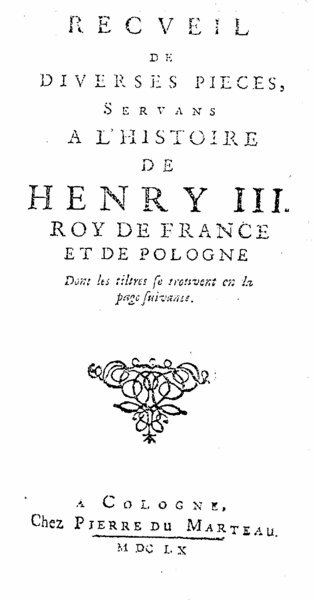
Amsterdam has become a major publishers-city (second besides Londom). There is also therefore that in many places is aken note of new insights. This applies to the publishers, but also for their patrons. Some rich merchants spend their wealth to doing book publishing and protecting writers (Louis and Laurens de Geer protects including Descartes ànd Comenius; Jarig Jelles Spinoza; Van Beyerlandt Jacob Böhme). Also among the magistrate are patrons (Johannes Hudde and Nicolaas Witsen). Book publishers have often played a role in the protection of innovative spirits, such as for example the Gouda printer Tournay. From 1660 Jean Elzevir starts editing under a PUBLISHERS PSEUDONYM (left): PIERRE DE MARTEAU to circumvent the censorship.
Constantijn Huygens protects Descartes and advises him a publisher (Blaeu, Amsterdam, Alkmaar, 1596-1673). Moreover, this does not always say that the patrons totally agree with the author. So Huygens also takes away from Descartes ' ideas. Another protegee of the Geers, Comenius, also doesnot agree on all points with Descartes.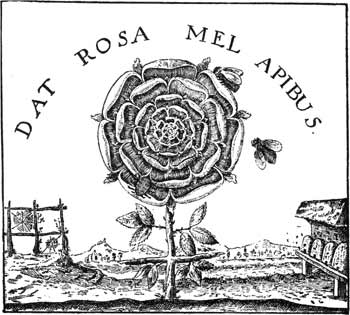
In Amsterdam are also published so-called hermetic books, books of wise men from all over the world in the line of the Egyptian 'wiseman' Hermes Trismegistus. Including a writings of Trismegistus itself (issued by Nicolaas van Ravesteyn). Some works from the ' Philosophica Hermetica' were published by Johannes Janssonius. Another publisher was Christopher Cunradus.
Amsterdam plays this way an important role in the exchange between intellectual networks in Central and West-Europe.
One of the many examples of international contact is that between the Sileziër Von Franckenberg and the English physician Robert FLUDD (author of SUMMUM BONUM, see cover right).
 Where the free thought threatened to be suppressed, arose a counter-movement. Moreover, not always with success. Mr. John Uytenbogardus (Singel 324) (see right, Rembrandt's JOHANNES UYTENBOGAERT) takes on for painter and rosicrucian Torrentius and informs Hugo Grotius. Nevertheless, he is sentenced (Uytenbogardus is a relative (cousin) of Johannes Wttenbogaert (1557-1644), which had a place on the ' driver ' DRECKWAGEN ARMINIAN and is considered as the successor of Arminius).
Where the free thought threatened to be suppressed, arose a counter-movement. Moreover, not always with success. Mr. John Uytenbogardus (Singel 324) (see right, Rembrandt's JOHANNES UYTENBOGAERT) takes on for painter and rosicrucian Torrentius and informs Hugo Grotius. Nevertheless, he is sentenced (Uytenbogardus is a relative (cousin) of Johannes Wttenbogaert (1557-1644), which had a place on the ' driver ' DRECKWAGEN ARMINIAN and is considered as the successor of Arminius).
3. CITY HALL ON THE DAM AFTER 1650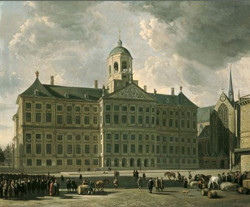 (left) DAM WITH CITY HALL (NOW PALACE) OF J. VAN CAMPEN AND NIEUWE KERK (Berckheyde, 1673)
(left) DAM WITH CITY HALL (NOW PALACE) OF J. VAN CAMPEN AND NIEUWE KERK (Berckheyde, 1673)
In 1650 (the war against the Spaniards ended in 1648) reached richness in Amsterdam a peak. The city has grown from 30,000 inhabitants in 1580 to 210.00 in 1650. There is then rapidly much built and of high quality. Much is left untill now. Before the Town Hall was small compared to the Church, the new City Hall which was built at that time, was great and high. Caution: larger and higher than the Church! There was waked for that the church tower not jutted above the City Hall. Against Van Campen plan for a high tower for the Church sparked resistance and the tower came not there. This fuss ideas on the relationship of Church and State, which is also found in Pieter de la Court's ' Interest van Holland ' (1662). Spinoza also finds: the Church must ultimately add to the State.
There was an exuberant atmosphere of Amsterdam. The town hall would be the eighth wonder of the world.
 Within the Dutch master-painters such as the Flemish Jacob JORDAENS (1593-1678) (right) could get started. The specified theme was: the ' REVOLT AGAINST the SPANIARDS ', what was imagined by the Batavians under CLAUDIUS CIVILIS rebelling against the Roman occupiers. France had supported Amsterdam, so it seemed. A French baroque ornate style, which partly by Flemish painters like Rubens, was imported, to honor the heroic rebels, was what the vroedschap liked.
Within the Dutch master-painters such as the Flemish Jacob JORDAENS (1593-1678) (right) could get started. The specified theme was: the ' REVOLT AGAINST the SPANIARDS ', what was imagined by the Batavians under CLAUDIUS CIVILIS rebelling against the Roman occupiers. France had supported Amsterdam, so it seemed. A French baroque ornate style, which partly by Flemish painters like Rubens, was imported, to honor the heroic rebels, was what the vroedschap liked.
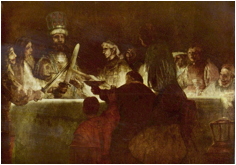
Also REMBRANDT (left) got a command for this. Only ... he painted Claudius as not as combative hero but as old man. In a staging, reminiscent of the Last Supper. He shows his strength in the forged unity and by threatening with the sword, but not by a fighting spirit. The principals did not like it and his work disappeared to the cellars. The other painters had did the heroiek of the ' Rebellion ' stressed.
Patriotic virtues, those of so-called Batavian origin, were in the spirit of Erasmus, Dirck Volckertszoon Coornhert and Hugo de Groot, sense of freedom, frankness, simplicity, frugality, courage, cleverness, peace-loving and sincere piety. The Batavians were a nation that not only aspired freedom but also cultivated equality. A people that does not have cherished the authority (vertical) central, but the family (horizontal) as the basis of society (Frijhoff, Spies, 1650). Maybe wanted Rembrandt to honor the spirit of this people in his painting.
POLITICAL DEVELOPMENTS UNTIL 1650
In 1648 through the peace of Münster he 80-year-old war with Spain and the thirty years war (1618-1648) came to end.
Reason for the 30-year-old war was a revolt in Bohemia (Czech Republic). Sweden and France were opponents of the Emperor of the Holy Roman Emperor Ferdinand II. The Republic with stadtholder Frederick Hendrik supported the Palts (capital Heidelberg), Bohemia and the in 1608 founded Protestants Union of Protestant princes and imperial cities. 
Grandson of William of Orange, the Protestant Frederick V of Bohemia van de Palts (1596-1632) (right, façade stone Egelantiersgracht 153/159), married the English Elizabeth Stuart (1596-1662), son of Countess Louise Juliana Princess of Orange (1576-1644) and grandson of William of Orange, played a role in the European Reformed case. His portrait also appears on the cover of Hobbes ' Leviathan. He comes to the Hague along with an extended family and court. In Amsterdam the guns producer Louis de Geer is closely connected with this Reformed movement.
There is a great relationship between the Dutch Court, the family van der Palts (also related to William of Orange), the English Court, particularly the Stuarts and the struggle for the Protestant cause. Also the Secretary of the stadtholders Frederick Hendrik, William II and William III and their diplomat, Constantijn Huygens, feel connected to the struggle for the Protestant cause. These courts are often important meetingpoints for artists, scientists and diplomats, who in this way mutually know each other.
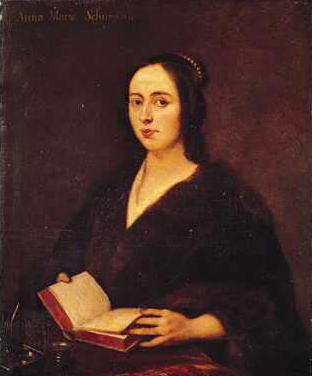 Constantijn Huygens meets on the English court Cornelis Drebbel and Frances Bacon. Also with the women coming to the courts they have regularly an intellectual exchange.Daughter of Frederik V van der Palts and Elisabeth Stuart, Elisabeth van der Palts (1618-1680) (right-hand column), corresponds to Descartes and maintains contact with the high-intelligent and developed ANNA MARIA VAN SCHURMAN (1607-1678) (self portrait, left). Descartes goes to Catharina of Sweden and maintains contact with Elisabeth van der Palts. The women play in plays which are made to show them honor, for example Maria Stuart.
Constantijn Huygens meets on the English court Cornelis Drebbel and Frances Bacon. Also with the women coming to the courts they have regularly an intellectual exchange.Daughter of Frederik V van der Palts and Elisabeth Stuart, Elisabeth van der Palts (1618-1680) (right-hand column), corresponds to Descartes and maintains contact with the high-intelligent and developed ANNA MARIA VAN SCHURMAN (1607-1678) (self portrait, left). Descartes goes to Catharina of Sweden and maintains contact with Elisabeth van der Palts. The women play in plays which are made to show them honor, for example Maria Stuart.
The early death of Willem II (1650) brought the Republican party to power with Johan de Witt as Grand Pensionary. His appointment, however, could only be done with the express consent of Amsterdam, then led by Mayor Cornelis de Graeff, the most successful Amsterdam mayor from the Golden Age, of whom the Witt was a cousin. The exemplary cooperation between the two politicians was an important factor in the success of the revival of the economy after Witts politics and the first Anglo-Dutch war. De Witt recognized fully the power of his uncle, and did his best to follow the Amsterdam wishes. He married the Amsterdamse Wendela Bicker (1635-1668), also from the influential Amsterdam genus Bicker; her father was Johan Bicker (1691-1653) and her mother Agneta de Graeff (1603-1656).
POLITICAL DEVELOPMENTS FROM 1650
Now there was peace with the Spaniards from1648 following the successful rebellion, new enemies came : first the English. The three English wars (1652-1654), (1665-1667) and (1672-1674) were especially focused on sea and supremacy in the colonies. The wars affect the success in the Republic. For example, Spinoza and Rembrandt camp in 1656 with financial difficulties. In 1663-1664, Amsterdam was hit by a epidemic plague. For Amsterdam and the Republic the Northern trade is the most important.
The war between Sweden and Denmark is likely to have had consequences for the Dutch interests of reasonable tolls. Johan de Witt in principle carries a diplomatic struggle based on defensive alliances, a policy in line with Hugo Grotius based on not to attack unless the country itself is attacked.
Between 1667 and 1696 one of the richest men of Europe, Cosimo III de Medici (1642-1723), Grand Duke of Tuscany, visits the Republic. He met, among others, Constantijn Huygens, Johannes van Neercassel, Heinsius, Vossius, Graevius, Swammerdam and several art collectors. Also he visits the Amsterdam Schouwburg, where Medea of Jan Vos is played. On his English travel he meets Oldenburg, Boyle and Newton. His son is likely to be raised by the Danish anatomist Niels Stensen. Later it will have contact with the son-in-law of Franciscus van den Enden. He gives Theodor Kerckring and Maria Clara financial support
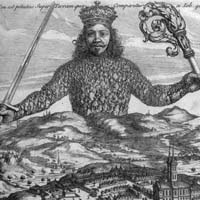
n 1667 is Hobbes ' LEVIATHAN (left), the matter, forme and power of a common wealth and civil ecclestiall ' (1651) in Dutch comes available, translated by Abraham van Berckel (1639-1686) and published by Elzevir; in 1668 in Latin.
Although work on the relationship of Church, State and power in many ways looks like Spinoza's TPT is Hobbes ' conclusion different: according to him is for a State with internal peace and a good defence against external enemies needs one central monarch, whose authority is absolute. A religious ' locus of power ' in addition to the worldly power he finds undesirable.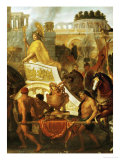
In a theological State and power go together on theocracy. but also when the separation between ecclesiastical and secular power is greater, finds the ruler support in a divine assent to his reign. Louis XIV also creates a divine image in order to support his power. He hereby no longer meets at a Christian support, but is similar to a classic hero, ALEXANDER the great (right), and with a naturalistic Centre: the Sun.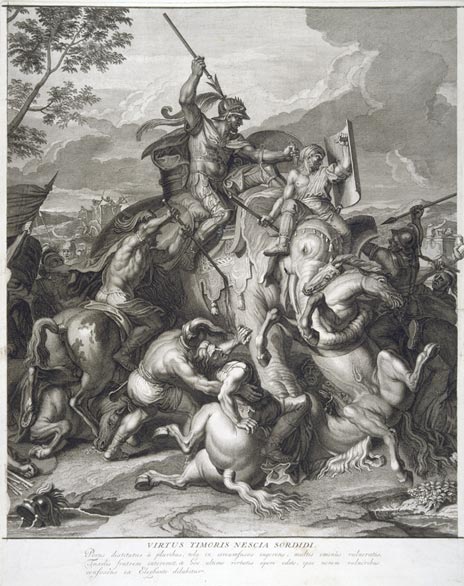
From 1667 Louis XIV Sun King is trying to expand his territory, first in the Spanish Netherlands, gradually towards the Flemish provinces.
Alexander the great was the example that Louis XIV made the people keep in mind. Lodewijk's favourite painter Charles le Brun, who is portrayed,in the Louvre next to the ' Sun King ' Louis XIV, glorified the slain in the fight for a monarch (left) on the ' ALEXANDER paintings (1660-1665) ', which he made in command of Louis XIV. By show these paintings, the people could compare him with Alexander ' the great '.
In 1667, an ' Eternal Edict ' (advocated in Pierre de la Court's ' The interest of Holland ' from 1662) was drawn up by Gaspar Fagel (1634-1688), Gillis Valckenier and (under reservations, tragically seen subsequent developments) Johan de Witt, which would have abolished the stadtholdership forever.
The Chairman of a Commission overseeing the education of William III (with, among others, Johann de Witt and Gaspar Fagel as members), the Amsterdam mayor  Gillis VALCKENIER (1623-1680) (left), puts however, already in 1668-1669 the door open for the Prince and makes a switch from State-minded to a Prince- inclined Board possible. Given the real threat of war of the French not incomprehensible. This calls for more centralization of governance.
Gillis VALCKENIER (1623-1680) (left), puts however, already in 1668-1669 the door open for the Prince and makes a switch from State-minded to a Prince- inclined Board possible. Given the real threat of war of the French not incomprehensible. This calls for more centralization of governance.
Coenraad van Beuningen (1622-1693) is the Witt's Ambassador in Sweden. He was formerly Secretary of Hugo Grotius. Hegets more and more trouble with the offensive action of Sweden for which he warns de Witt . From 1668 the French, the former allies against the Spaniards, begin to enter the North. Also in France, Van Beuningen becomes ambassador. Johan de Witt likes through diplomatic agreements to come to a Covenant with Louis XIV with the southern Netherlands under common management. He assumes that the English and the French will remain separate, but these constitute a Covenant. Van Beuningen warns the Witt for the expansion strive of Louis XVI.
In 1670 the (secret) Treaty of Dover (also called "Treatise of Dover ') was made between Charles II of England and Louis XIV of France. Charles promised to convert to Catholicism himself and England here and to leave the Triple Alliance, the Alliance with Sweden and the Republic of the Seven United Netherlands. England then would be France's ally in its war against the Dutch Republic. Louis , for his part, promised Charles on adequate financial resources to be less dependent of the English Parliament, and military support in the form of an army of 6000 men, should it come to an internal resistance. England became involved by this Treaty in the French-Dutch war and declared on 28 March 1672 war on the Dutch Republic.
Early 1672 the French (with in the wake the Catholic faith) come in the Netherlands and occupy Utrecht among others. The beginning of the Franco-Dutch war, which ends in 1679. 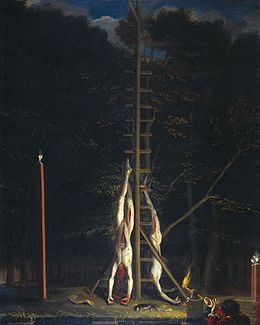 In 1672 (the Disaster year) ' the country was helpless, the Regents distraught andpeople irrational . In the Hague half a year after the start of the invasion the brothers DE WITT were MURDERED (right) and exhibited. It is likely that the 22-year-old William III was aware in advance that the de Witten would be put outside game. Possible the Rotterdam Johan Kievit and Cornelis Tromp played a role.
In 1672 (the Disaster year) ' the country was helpless, the Regents distraught andpeople irrational . In the Hague half a year after the start of the invasion the brothers DE WITT were MURDERED (right) and exhibited. It is likely that the 22-year-old William III was aware in advance that the de Witten would be put outside game. Possible the Rotterdam Johan Kievit and Cornelis Tromp played a role.
Change the form of Government: William III (1650-1702), stadtholder (but a moderate form). The ' Eternal Edict ' terminated in 1672 because it would be incompatible with the post of Captain-General and Admiral-General. Fagel becomes William III's Advise Pensionary. The fierce anti-orangist Pierre de la Court leaves in 1672 the country.
In 1672, Stadholder William III on the advice of Council , Valckenier put sixteen members from the Amsterdam Council including Henrick Hooft, Pieter de Graeff and Andries & Lambert Reynst. Coenraad VAN BEUNINGEN (1625-1672) (left), who has been attracted to Spinoza and the collegiants Rijnsburgse felt longer, Nicolaas Witsen (1641-1717), Johannes Hudde and other family members came in their place: supporters of Spinoza's philosophy.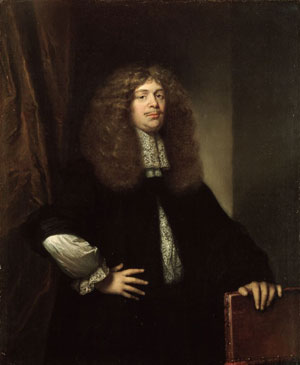
Holland in 1672, would also have been captured if not rushedly a water line would be installed. Utrecht feels still a century these recoil and also in the rest of the Republic is done with the prosperity.
On 19 February 1674 withdrawed England itself, for the sake of domestic political issues, from the fight. The French knew to win the battle of Cassel, without English support. Later England finally pulled back on his promises and supported the Dutch again in their fight against France. Van Beuningen, than in the vroedschap of Amsterdam, trying to follow a policy of consultation with Louis XIV in 1675 .
The historical assessment of the role of William III is, that he against the expectation in a targeted rate has followed on the interests of the low countries and has played an important diplomatic role in the European opposition to the French King Louis XIV. Both the Netherlands and France are financially exhausted. Ultimately, England in the 18th century is the smiling third.
After the signing of the peace with France in 1679 in Amsterdam and the Republic appears to have emerged a more Frenchdirected culture: more than formerly focused on grandeur. When the more and more getting Catholic Louis XIV in 1685 ends the Edict of Nantes of 1598, which had given the Huguenots rights of practising their faith and have garrison force in some cities, many Huguenots flight to the Republic. Christiaan Huygens, which in France is to make a contribution to establishing a French ' Royal Society ' and until then had drawn up neutral, goes back to neutral Holland
47. PEDAGOGY AND FAMILY LIFE (Keizersgracht 123: Comenius; Gelderse kade 16: Roemer Visscher)
According to Schama the Dutch at the time of the Republic were very attached to family life. And this looked particularly in the eyes of foreigners: the children were scoundrels and were more than in other countries hugged.
Murmellius (1480-1517) had written' Kinderpap ', with an emphasis in the tutorial on ' many admonitions ' and little on penalties. It was quite common for schools to save and humiliate poor-learning pupils. According to Murmellius another teaching method was possible: who could promote the motivation of the learner knew that cruel punishment is not necessary. Murmellius himself had had lessons of Alexander Hegius von HEEK in Deventer (1433-1498), who also had followed Erasmus classes. Murmellius was rector of the Latin school in Alkmaar, where in that time Jan van Scorel (1495-1561) and Amsterdam Alardus (1495-1544) followed lessons.
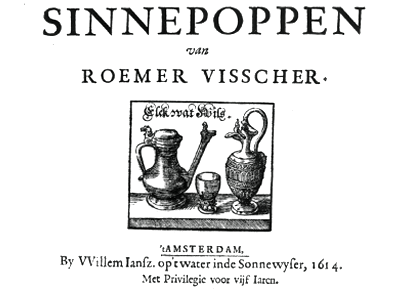 Roemer Visscher had written 'Sinnepoppen' (1614), illustrated by the well-known engraver Claes Jansz Visscher (no family). The titlepage seems to refer to a Rosicrucian painting of Torrentius from 1614.
Roemer Visscher had written 'Sinnepoppen' (1614), illustrated by the well-known engraver Claes Jansz Visscher (no family). The titlepage seems to refer to a Rosicrucian painting of Torrentius from 1614.

Left a class of pedagogue Jan Amos COMENIUS, who is often in the Netherlands. He stresses the importance of informative education. It is also to see that he learns about nature: he points to the stars, plants, etc. Comenius also writes books for mothers about how, where and at what age their children can learn the most.


